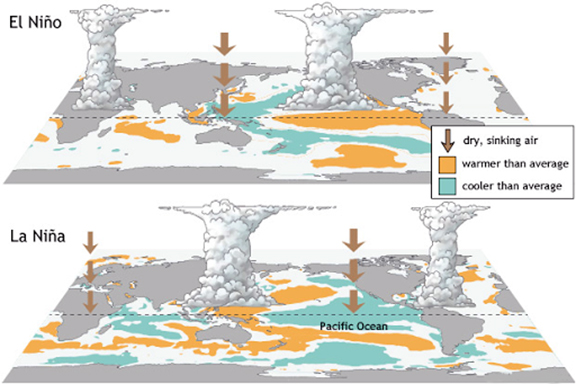Geography
Impact of Climate Change on El Nino and La Nina
- 06 Sep 2021
- 5 min read
Why in News
According to recent research, climate change can cause extreme and more frequent El Niño and La Niña events.
- The findings have been obtained using one of South Korea’s fastest supercomputers, Aleph.
Key Points
- About the Recent Findings:
- Increasing atmospheric carbon dioxide can cause a weakening of future simulated El Nino-Southern Oscillation (ENSO) sea surface temperature variability.
- Future El Niño events will lose heat to the atmosphere more quickly due to the evaporation of water vapour. Also, in the future there will be a reduced temperature difference between the eastern and western tropical Pacific, inhibiting the development of temperature extremes during the ENSO cycle.
- There can be a weakening of Tropical Instability Waves (TIWs) in the projected future which can cause a disruption of the La Niña event.
- TIWs are a dominant feature of monthly variability in the equatorial Pacific and Atlantic Ocean.
- ENSO:
- El Nino and the Southern Oscillation, also known as ENSO is a periodic fluctuation in sea surface temperature (El Niño) and the air pressure of the overlying atmosphere (Southern Oscillation) across the equatorial Pacific Ocean.
- El Nino and La Nina are complex weather patterns resulting from variations in ocean temperatures in the Equatorial Pacific Region. They are opposite phases of what is known as the ENSO cycle.
- El Nino and La Nina episodes typically last nine to 12 months, but some prolonged events may last for years.
- El Nino:
- About:
- El Nino is a climate pattern that describes the unusual warming of surface waters in the eastern tropical Pacific Ocean.
- It is the “warm phase” of ENSO.
- It occurs more frequently than La Nina.
- El Nino is a climate pattern that describes the unusual warming of surface waters in the eastern tropical Pacific Ocean.
- Impact:
- The warmer waters cause the Pacific jet stream to move south of its neutral position. With this shift, areas in the northern US and Canada are dryer and warmer than usual. But in the US Gulf Coast and Southeast, these periods are wetter than usual and have increased flooding.
- As El Nino brings rain to South America, it brings droughts to Indonesia and Australia.
- El Niño also has a strong effect on marine life off the Pacific coast.
- During normal conditions, upwelling brings water from the depths to the surface; this water is cold and nutrient rich.
- During El Niño, upwelling weakens or stops altogether. Without the nutrients from the deep, there are fewer phytoplankton off the coast. This affects fish that eat phytoplankton and, in turn, affects everything that eats fish.
- The warmer waters can also bring tropical species, like yellowtail and albacore tuna, into areas that are normally too cold.
- About:
- La Nina:
- About:
- La Nina, the “cool phase” of ENSO, is a pattern that describes the unusual cooling of the tropical eastern Pacific.
- La Nina events may last between one and three years, unlike El Nino, which usually lasts no more than a year.
- Both phenomena tend to peak during the Northern Hemisphere winter.
- La Nina, the “cool phase” of ENSO, is a pattern that describes the unusual cooling of the tropical eastern Pacific.
- Impact:
- Off the west coast of the Americas, upwelling increases, bringing cold, nutrient-rich water to the surface.
- It usually has a positive impact on the fishing industry of western South America.
- It can also lead to a more severe hurricane season.
- Causes the jet stream to move northward and to weaken over the eastern Pacific.
- Causes drought in the South American countries of Peru and Ecuador.
- There are increased temperatures in Western Pacific, Indian Ocean and off the Somalian coast. It also leads to heavy floods in Australia.
- About:





